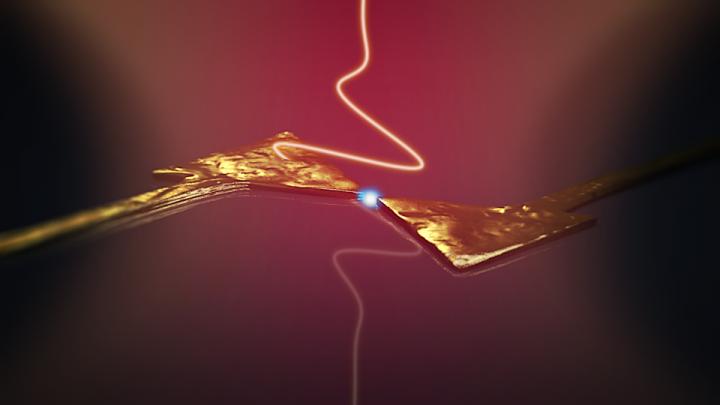
Credit: University of Konstanz
Contemporary electronic components, which are traditionally based on silicon semiconductor technology, can be switched on or off within picoseconds (i.e. 10-12 seconds). Standard mobile phones and computers work at maximum frequencies of several gigahertz (1 GHz = 109 Hz) while individual transistors can approach one terahertz (1 THz = 1012 Hz). Further increasing the speed at which electronic switching devices can be opened or closed using the standard technology has since proven a challenge. A recent series of experiments – conducted at the University of Konstanz and reported in a recent publication in Nature Physics – demonstrates that electrons can be induced to move at sub-femtosecond speeds, i.e. faster than 10-15 seconds, by manipulating them with tailored light waves.
“This may well be the distant future of electronics”, says Alfred Leitenstorfer, Professor of Ultrafast Phenomena and Photonics at the University of Konstanz (Germany) and co-author of the study. “Our experiments with single-cycle light pulses have taken us well into the attosecond range of electron transport”. Leitenstorfer and his team from the Department of Physics and the Center for Applied Photonics (CAP) at the University of Konstanz believe that the future of electronics lies in integrated plasmonic and optoelectronic devices that operate in the single-electron regime at optical – rather than microwave – frequencies.
###
Read the full story on the University of Konstanz’s news website after the embargo has lifted: https:/
Facts:
– International team of researchers including scientists from the University of Konstanz manages to control the ultrafast motion of electrons in a metallic nanocircuit by manipulating them with light.
– New method for speeding up the way electronic devices may be switched in the future.
– Original publication: Markus Ludwig, Garikoitz Aguirregabiria, Felix Ritzowsky, Tobias Rybka, Dana Codruta Marinica, Javier Aizpurua, Andrei G. Borisov, Alfred Leitenstorfer, Daniele Brida, Sub-femtosecond electron transport in a nanoscale gap, Nature Physics, 23 December 2019 (DOI: https:/
– Funded by the Spanish Ministry of Science, Innovation and Universities (MICINN), Eusko Jaurlaritza (Basque Government), the German Research Foundation (DFG), the EC | EU Framework Programme for Research and Innovation H2020 | H2020 Priority Excellent Science | H2020 European Research Council (H2020 Excellent Science – European Research Council).
– Contact person at the University of Konstanz: Professor Alfred Leitenstorfer, Department of Physics ([email protected]).
Note to editors:
You can download a photo here: https:/
Caption: Illustration of how electrons can be imagined to move between two arms of a metallic nanoantenna, driven by a single-cycle light wave.
Image: University of Konstanz
Contact:
University of Konstanz
Communications and Marketing
Phone: +49 7531 88-3603
Email: [email protected]
Media Contact
Julia Wandt
[email protected]
Related Journal Article
http://dx.




